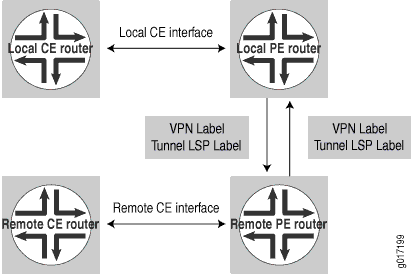Layer 2 Circuit Overview
A Layer 2 circuit is a point-to-point Layer 2 connection transported using Multiprotocol Label Switching (MPLS) or other tunneling technology on the service provider’s network. A Layer 2 circuit is similar to a circuit cross-connect (CCC), except that multiple virtual circuits (VCs) are transported over a single shared label-switched path (LSP) tunnel between two provider edge (PE) routers. In contrast, each CCC requires a separate dedicated LSP.
The Junos OS implementation of Layer 2 circuits supports only the remote form of a Layer 2 circuit; that is, a connection from a local customer edge (CE) router to a remote CE router. Figure 1 illustrates the components of a Layer 2 circuit.

To establish a Layer 2 circuit, the Label Distribution Protocol (LDP) is used as the signaling protocol to advertise the ingress label to the remote PE routers. For this purpose, a targeted remote LDP neighbor session is established using the extended discovery mechanism described in LDP, and the session is brought up to the remote PE loopback IP address. Because LDP looks at the Layer 2 circuit configuration and initiates extended neighbor discovery for all the Layer 2 circuit neighbors (the remote PEs), no new configuration is necessary in LDP. Each Layer 2 circuit is represented by the logical interface connecting the local PE router to the local customer edge (CE) router. Note that LDP must be enabled on the lo0.0 interface for extended neighbor discovery to function correctly.
Packets are sent to remote CE routers over an egress VPN label advertised by the remote PE router, using a targeted LDP session. The VPN label is sent over an LDP LSP to the remote PE router connected to the remote CE router. Return traffic from the remote CE router destined to the local CE router is sent using an ingress VPN label advertised by the local PE router, which is also sent over the LDP LSP to the local PE router from the remote PE router.
